Treatments beneficial to mitigate animal stress responses after handling and shipping
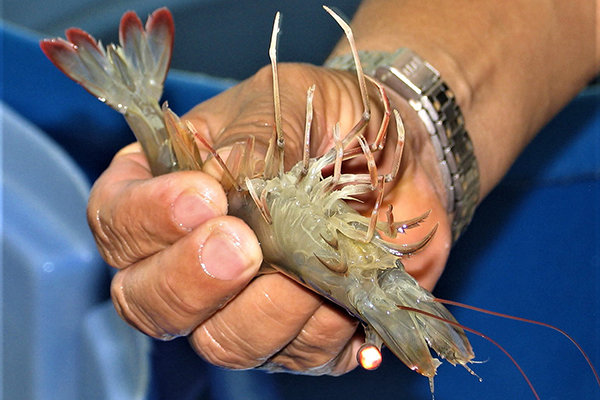
Various fish and shellfishes are usually subjected to several stressors, including capture, handling, crowding, induced spawning and transportation in the aquaculture, which influence the physiological stress response and mechanical damage. Hence, a variety of anesthetic agents are effective to reduce stress and risk of injuries during various aquaculture procedures. Among them, eugenol – a liquid extracted from clove, basil, nutmeg, cinnamon and other plants – is the most commonly used anesthetic and has demonstrated its efficacy, safety and affordability as a crustacean anesthetic. However, the efficacy of eugenol is closely related to various factors, resulting in variations of the induction and recovery times. Hence, the safety of eugenol should be evaluated when it is used in certain species.
The Pacific white shrimp (Litopenaeus vannamei) is the most important farmed shrimp species in the world. Large numbers are regularly moved live globally, and the animals can suffer damage and stress during capture, handling and crowding in transportation, resulting in high morbidity and low post-transport survival rate. There is no related research on the anesthetic efficacy and safety of eugenol in Pacific white shrimp.
This article – adapted and summarized from the original publication [Tang, Y. et al. 2022. Pharmacokinetics studies of eugenol in Pacific white shrimp (Litopenaeus vannamei) after immersion bath. BMC Vet Res 18, 122 (2022)] – reports on a study to investigate the pharmacokinetics [fate of substances administered to a living organism], tissue distributions and elimination of eugenol are investigated in L. vannamei for the first time.
Study setup
Approximately 1,500 L. vannamei (12 ± 2.0 grams) were purchased from a commercial supplier in Shanghai (China), and divided into six, 800-liter tanks with a fully aerated, circular water flow system. The shrimp were acclimated for 21 days, and six shrimp were examined to confirm the original absence of eugenol in hemolymph, hepatopancreas and muscle.
To investigate the anesthetic efficacy of high eugenol concentrations on shrimp by immersion baths, eugenol dissolved in 95 percent ethanol (ratio of eugenol to ethanol, 1:9) at 100, 150, 200, 300 and 400 mg per liter of eugenol were evaluated at 20 ± 0.5 degrees-C. Ten shrimp were exposed to each concentration.
The pharmacokinetics of eugenol were investigated by immersion baths of 300 mg/L eugenol over 5 minutes (Treatment 1), 10 mg/L eugenol during 24 hours (Treatment 2) and a sequential immersion administration (Treatment 3). Tissue samples were collected at different times for up to 120 hours following the eugenol immersion bath, and the concentrations of eugenol in hemolymph, hepatopancreas and muscle were determined through standard analytical methods.
For detailed information on the experimental design and animal husbandry; sample collection, preparation and analysis; and statistical and pharmacokinetic calculations, refer to the original article.
Effect of agavin on beneficial microbes within Pacific white shrimp
Results and discussion
Anesthetics have been widely used for aquaculture animals to avoid injuries and stress, ensuring adequate animal quality and safety during handling and transportation. Thus, it is important to assess the efficacy of the anesthetic dose in different aquaculture species.
After an immersion bath of Treatment 1, the elimination half-life values were 1.3 hours and 11 hours for hepatopancreas and muscles, indicating the rapid absorption and elimination of eugenol in shrimp. For Treatment 2, the eugenol peak concentration was 6527.9 μg/kg in muscle, followed by 402.8 μg/kg in hepatopancreas, with the lowest concentration of 37.9 μg/L in hemolymph.
Average residence time were 38.6, 23.0 and 115.3 hours for hemolymph, hepatopancreas and muscle, respectively, which may indicate that the hepatopancreas is the main organ for elimination of eugenol. Overall, our results suggest that eugenol tends to accumulate mostly in muscle, and after the immersion bath, eugenol concentrations in muscle of Pacific white shrimp were lower than 2.5 mg/kg at 2 hours, 48 hours and 24.5 hours in Treatments 1–3, respectively.
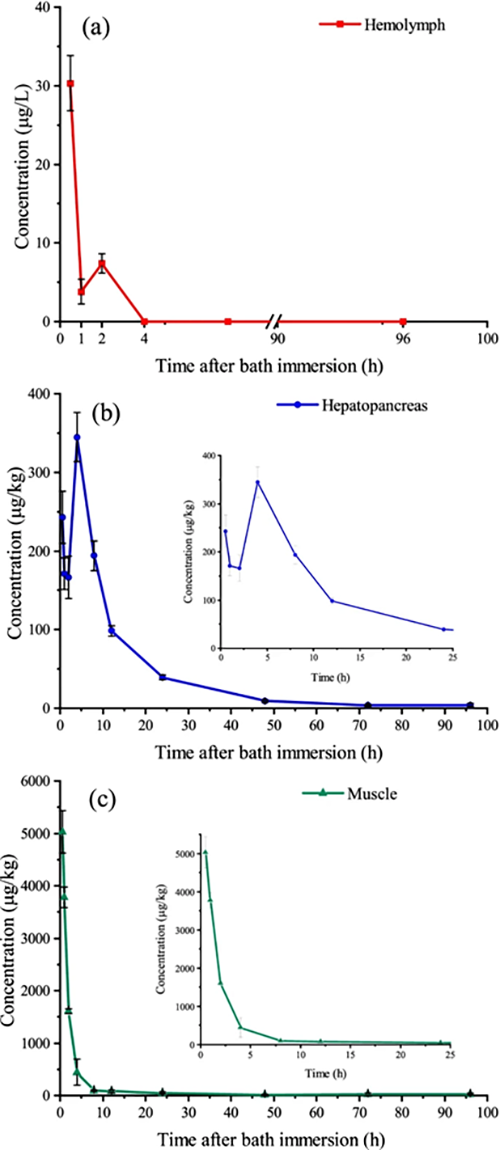
Three hundred micrograms per liter (μg/L) of eugenol over a 5-minute immersion bath (Treatment 1) proved to have adequate anesthetic effects in the manipulation procedures of L. vannamei. The eugenol was depurated in hemolymph after 2 hours and the value decreased from 5026.6 μg/kg to 81.2 μg/kg in muscle at about 12 hours (Fig. 1). Other authors have reported similar results in grass carp and silver perch. Overall, our observations suggest that eugenol metabolism is rapid over a short time.
To simulate the process of handling and transportation, the short-term and long-term treatments were combined in a sequential immersion bath. The maximum concentration values [Cmax, a standard measurement in pharmacokinetics, is the maximum or peak serum concentration that a drug achieves in a specified compartment or test area of the body after the drug has been administered and before the administration of a second dose] of eugenol were 50.0 μg/L, 413.1 μg/kg and 7623.0 μg/kg in hemolymph, hepatopancreas and muscle, indicating that eugenol accumulates in the hemolymph, hepatopancreas and muscle. Compared to the peak concentrations in single-dose administration, higher values could be observed in multiple-dose administration for several drugs, as reported by numerous studies that report that most drugs tend to accumulate in shrimp hemolymph, hepatopancreas and muscle.
Our observations also suggest that the elimination rate of eugenol in shrimp is more rapid than for several fish species. Similar results have been reported by various authors for the elimination of other drugs like sulfamethoxazole, oxytetracycline and trimethoprim in shrimp compared to several fish species, which may be ascribed to the especial anatomy and physiology of shrimp, with its open circulatory system which results in rapid drug excretion through the hemolymph and hepatopancreas.
We observed residual eugenol concentrations of 1.60, 2.43 and 1.77 mg/kg in shrimp muscle after 2 hours during the short-term immersion (Treatment 1), 48 hours in the long-term immersion (Treatment 2) and 24.5 hours in the sequential immersion administrations (Treatment 3), which are both lower than the concentration of 2.5 mg/kg recommended by the Joint FAO/WHO Expert Committee on Food Additives (JECFA) for acceptable daily intake in humans. Thus, 2 days is recommended as a minimum withdrawal period of Pacific white shrimp after any long-time eugenol exposure for human consumption.
Moringa leaf extract can boost Pacific white shrimp immune responses
Perspectives
Based on our results, eugenol concentrations of 10 and 300 mg per liter are efficacious and suitable for sedation and anesthesia in Pacific white shrimp weighing 12 ± 2.0 grams, and beneficial to mitigate the stress response after shrimp handling and transportation, improving biochemical responses and reducing mortality.
This is the first study of pharmacokinetics and depuration of eugenol in 12 ± 2.0-gram Pacific white shrimp by immersion bath treatment. The pharmacokinetics of eugenol indicated a rapid absorption and elimination in shrimp. To ensure the safe consumption of Pacific white shrimp, a withdrawal period of two days is recommended as the minimum withdrawal period of Pacific white shrimp after any long-time eugenol exposure. Our future work will evaluate the potential effects and concentrations on other shrimp sizes.
Now that you've reached the end of the article ...
… please consider supporting GSA’s mission to advance responsible seafood practices through education, advocacy and third-party assurances. The Advocate aims to document the evolution of responsible seafood practices and share the expansive knowledge of our vast network of contributors.
By becoming a Global Seafood Alliance member, you’re ensuring that all of the pre-competitive work we do through member benefits, resources and events can continue. Individual membership costs just $50 a year.
Not a GSA member? Join us.
Author
-
Xuanyun Huang, Ph.D.
Corresponding author
East China Sea Fisheries Research Institute, Chinese Academy of Fishery Sciences, Shanghai, P. R. China
Tagged With
Related Posts
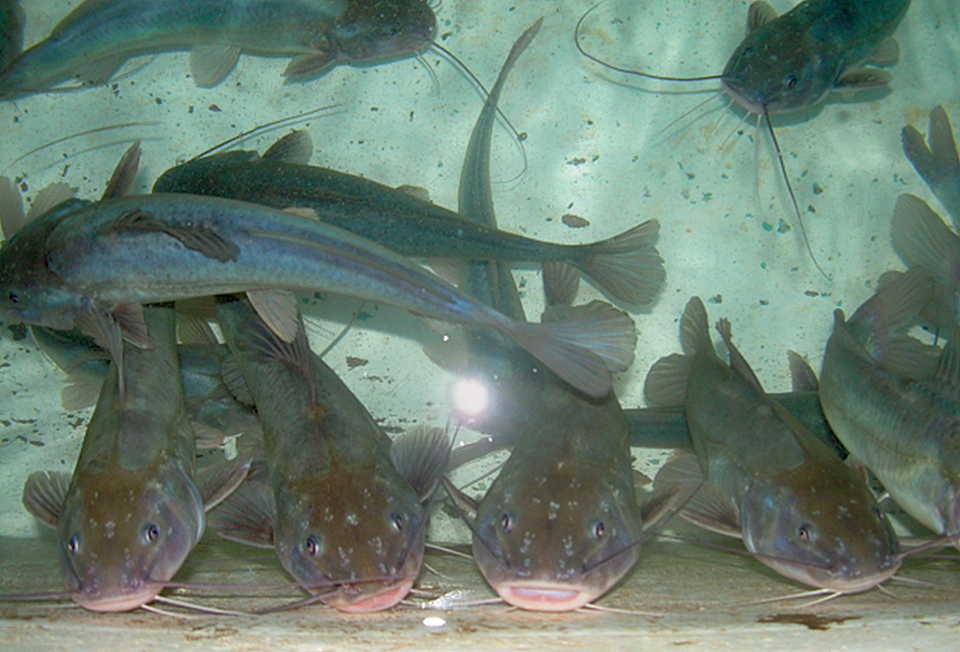
Health & Welfare
Clove oil, eugenol effective anesthetics for silver catfish
Clove oil and eugenol have been recommended and used as anesthetics for several fish species. Moreover, these products have received the attention of researchers because of their chemo-preventive effects, as well as their anti-inflammatory and antioxidant properties.
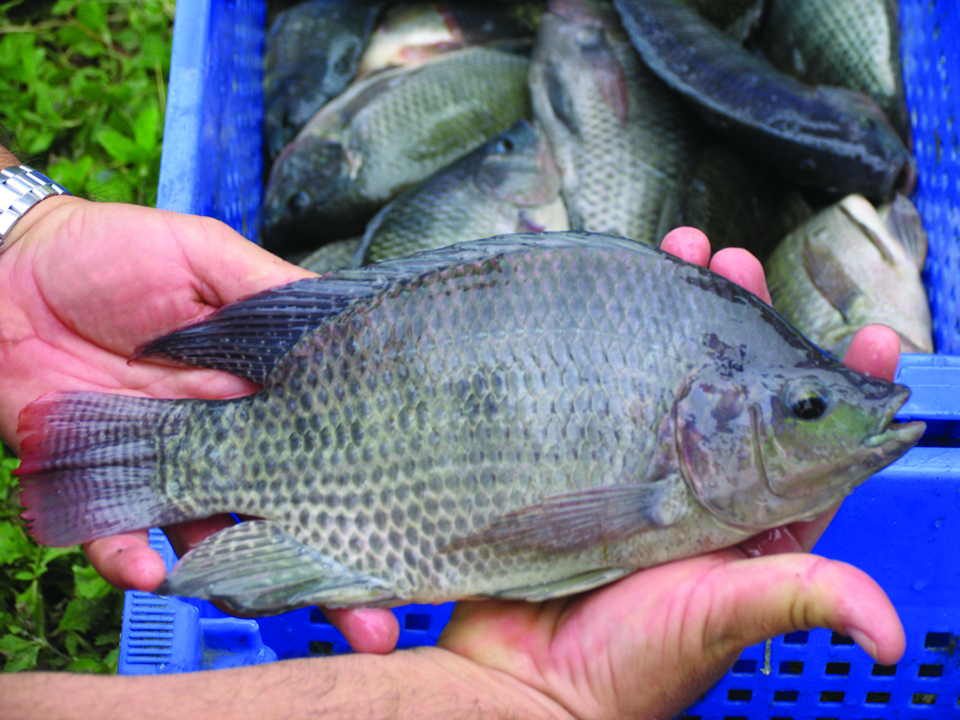
Health & Welfare
American fisheries society calls for immediate-release fish sedatives
The absence of practical immediate-release sedatives for fish jeopardizes fish, fisheries, fish culture and research, posing risks to aquatic resources as well as those handling fish.

Health & Welfare
New aquaculture drugs under FDA review
Only eight active pharmaceutical ingredients available in 18 drug products have been approved by the U.S. Food and Drug Administration for use in aquaculture. The approval process can be lengthy and expensive.
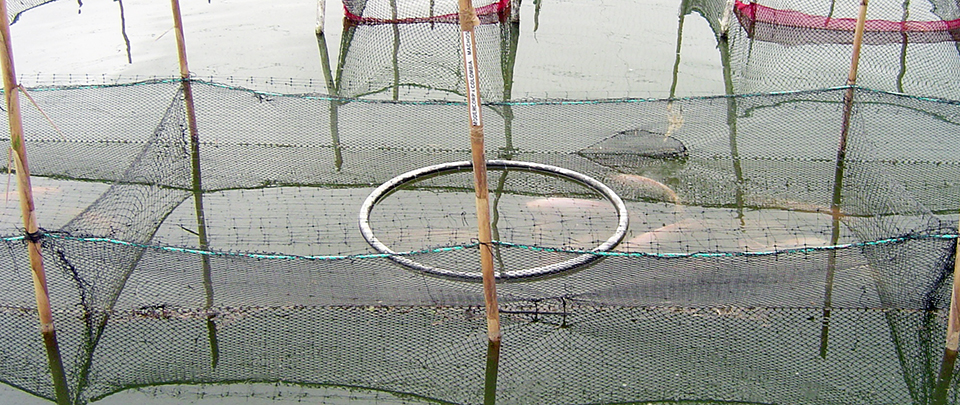
Health & Welfare
Study finds alternative anesthetic safe for tilapia fingerlings, breeders
Studies have proposed the use of anesthetics obtained from natural sources as alternatives to conventional chemicals. The authors recently evaluated the efficacy of the anesthetic Eugenol with a small sampling of red tilapia fingerlings and breeders.



